A Research Proposal on Absenteeism and Employee Productivity
VerifiedAdded on 2023/06/10
|14
|1601
|373
Report
AI Summary
This research proposal provides a critical analysis of the effect of absenteeism on employee productivity. It introduces the problem, highlighting its negative impact on employee careers and organizational resources. The literature review summarizes causes of absenteeism, including harassment, stress, and lack of flexibility, as well as organizational factors like uncooperative environments and external factors like social and legal changes. The proposal outlines a methodology employing a quantitative research approach and exploratory research design, utilizing primary data collected from an automated tracker system and employee interviews. Data analysis will be conducted using quantitative techniques. The proposal concludes by emphasizing the importance of addressing absenteeism through absence management systems and workplace wellness programs, with an estimated completion time of 24 weeks. Desklib provides access to similar solved assignments and past papers for students.
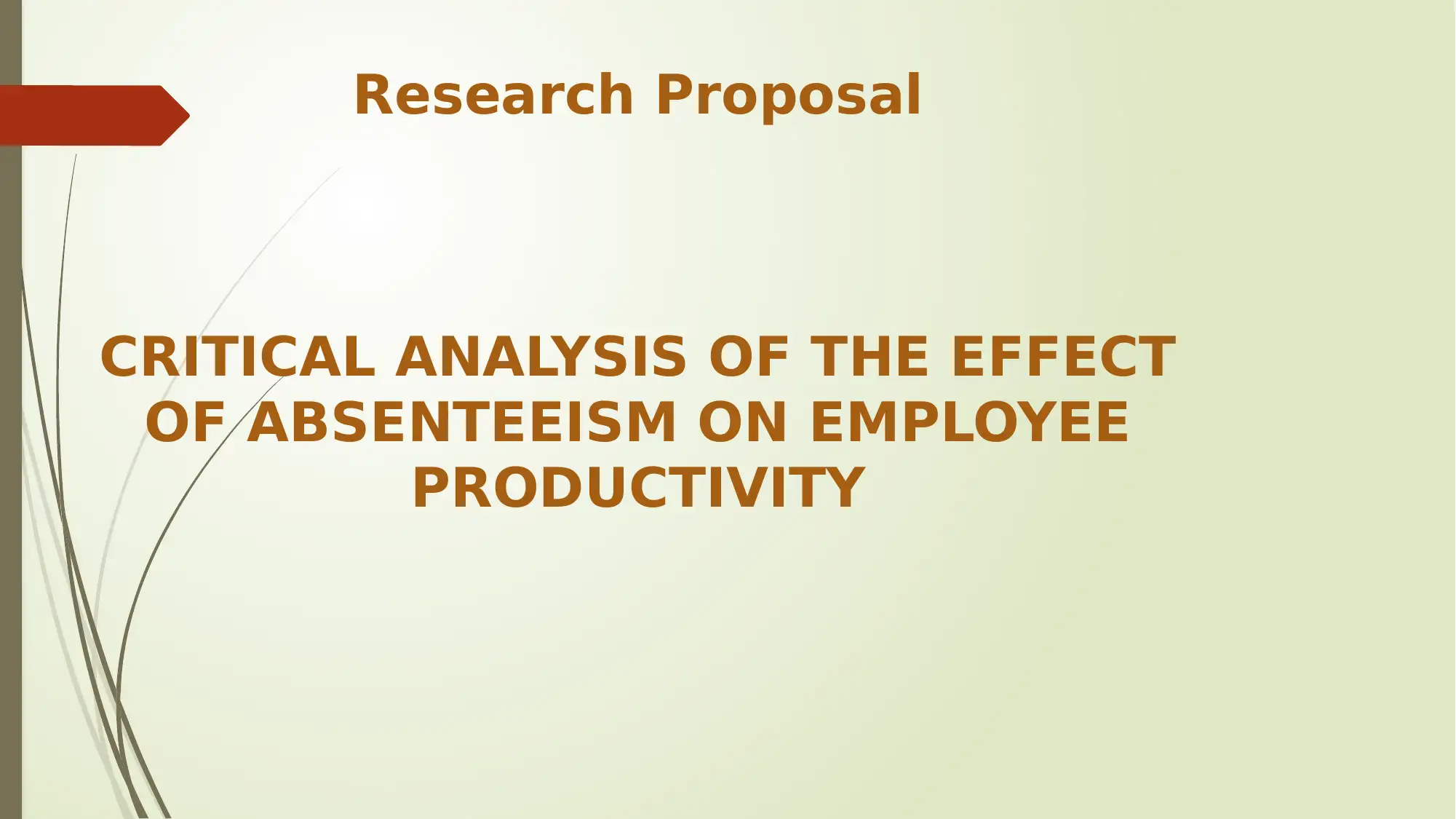
Research Proposal
CRITICAL ANALYSIS OF THE EFFECT
OF ABSENTEEISM ON EMPLOYEE
PRODUCTIVITY
CRITICAL ANALYSIS OF THE EFFECT
OF ABSENTEEISM ON EMPLOYEE
PRODUCTIVITY
Paraphrase This Document
Need a fresh take? Get an instant paraphrase of this document with our AI Paraphraser
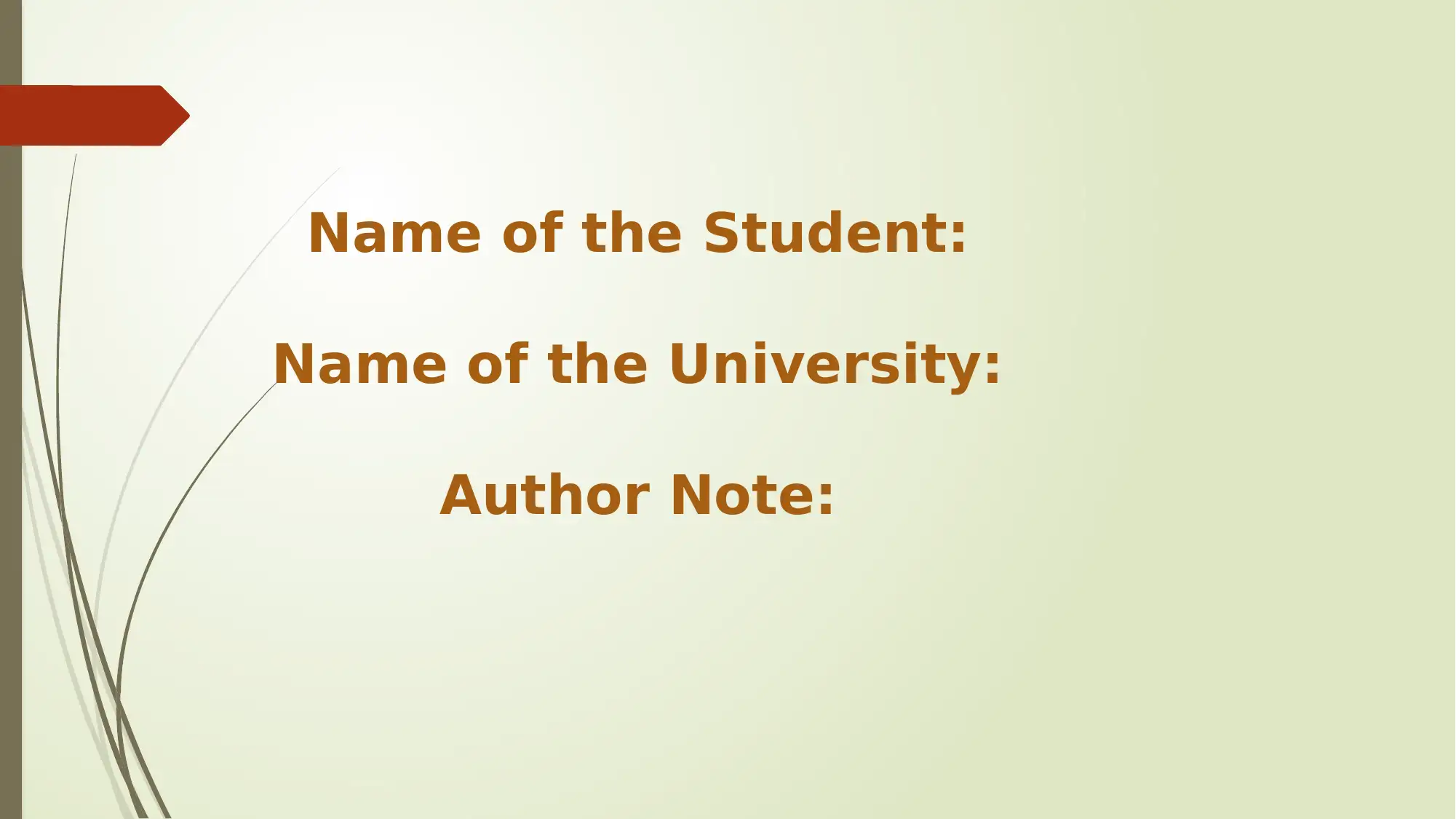
Name of the Student:
Name of the University:
Author Note:
Name of the University:
Author Note:
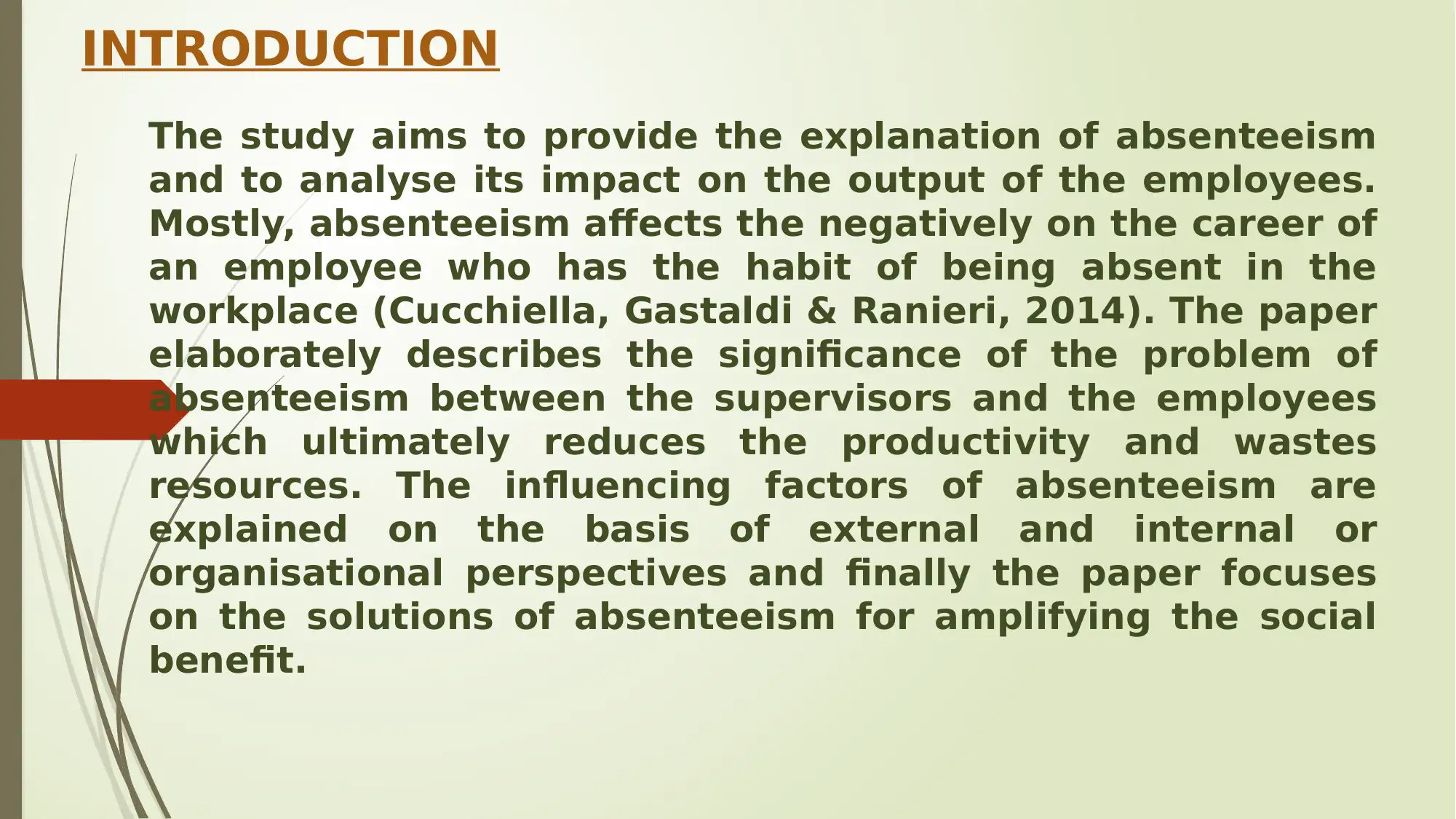
INTRODUCTION
The study aims to provide the explanation of absenteeism
and to analyse its impact on the output of the employees.
Mostly, absenteeism affects the negatively on the career of
an employee who has the habit of being absent in the
workplace (Cucchiella, Gastaldi & Ranieri, 2014). The paper
elaborately describes the significance of the problem of
absenteeism between the supervisors and the employees
which ultimately reduces the productivity and wastes
resources. The influencing factors of absenteeism are
explained on the basis of external and internal or
organisational perspectives and finally the paper focuses
on the solutions of absenteeism for amplifying the social
benefit.
The study aims to provide the explanation of absenteeism
and to analyse its impact on the output of the employees.
Mostly, absenteeism affects the negatively on the career of
an employee who has the habit of being absent in the
workplace (Cucchiella, Gastaldi & Ranieri, 2014). The paper
elaborately describes the significance of the problem of
absenteeism between the supervisors and the employees
which ultimately reduces the productivity and wastes
resources. The influencing factors of absenteeism are
explained on the basis of external and internal or
organisational perspectives and finally the paper focuses
on the solutions of absenteeism for amplifying the social
benefit.
⊘ This is a preview!⊘
Do you want full access?
Subscribe today to unlock all pages.

Trusted by 1+ million students worldwide
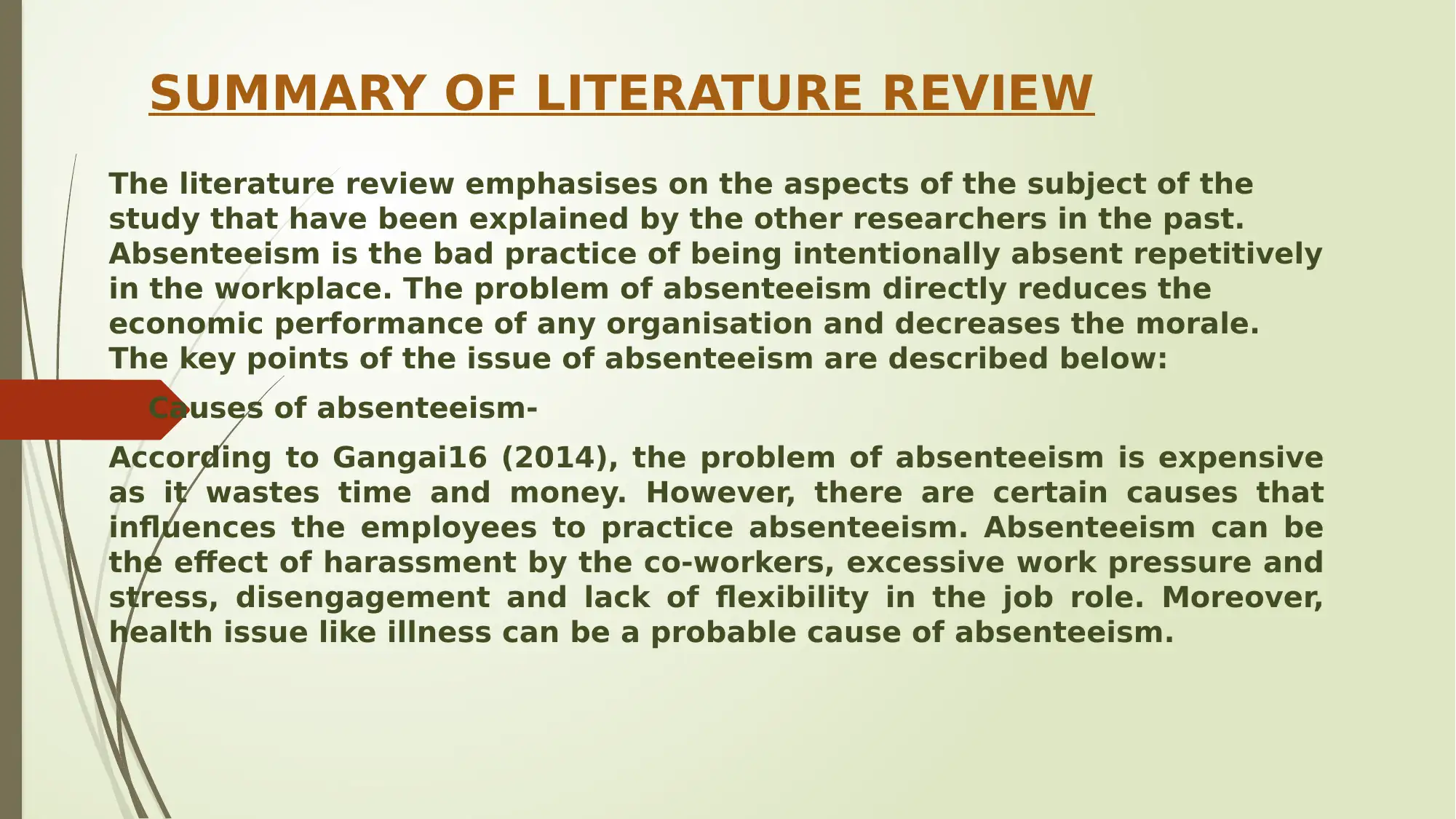
SUMMARY OF LITERATURE REVIEW
The literature review emphasises on the aspects of the subject of the
study that have been explained by the other researchers in the past.
Absenteeism is the bad practice of being intentionally absent repetitively
in the workplace. The problem of absenteeism directly reduces the
economic performance of any organisation and decreases the morale.
The key points of the issue of absenteeism are described below:
Causes of absenteeism-
According to Gangai16 (2014), the problem of absenteeism is expensive
as it wastes time and money. However, there are certain causes that
influences the employees to practice absenteeism. Absenteeism can be
the effect of harassment by the co-workers, excessive work pressure and
stress, disengagement and lack of flexibility in the job role. Moreover,
health issue like illness can be a probable cause of absenteeism.
The literature review emphasises on the aspects of the subject of the
study that have been explained by the other researchers in the past.
Absenteeism is the bad practice of being intentionally absent repetitively
in the workplace. The problem of absenteeism directly reduces the
economic performance of any organisation and decreases the morale.
The key points of the issue of absenteeism are described below:
Causes of absenteeism-
According to Gangai16 (2014), the problem of absenteeism is expensive
as it wastes time and money. However, there are certain causes that
influences the employees to practice absenteeism. Absenteeism can be
the effect of harassment by the co-workers, excessive work pressure and
stress, disengagement and lack of flexibility in the job role. Moreover,
health issue like illness can be a probable cause of absenteeism.
Paraphrase This Document
Need a fresh take? Get an instant paraphrase of this document with our AI Paraphraser
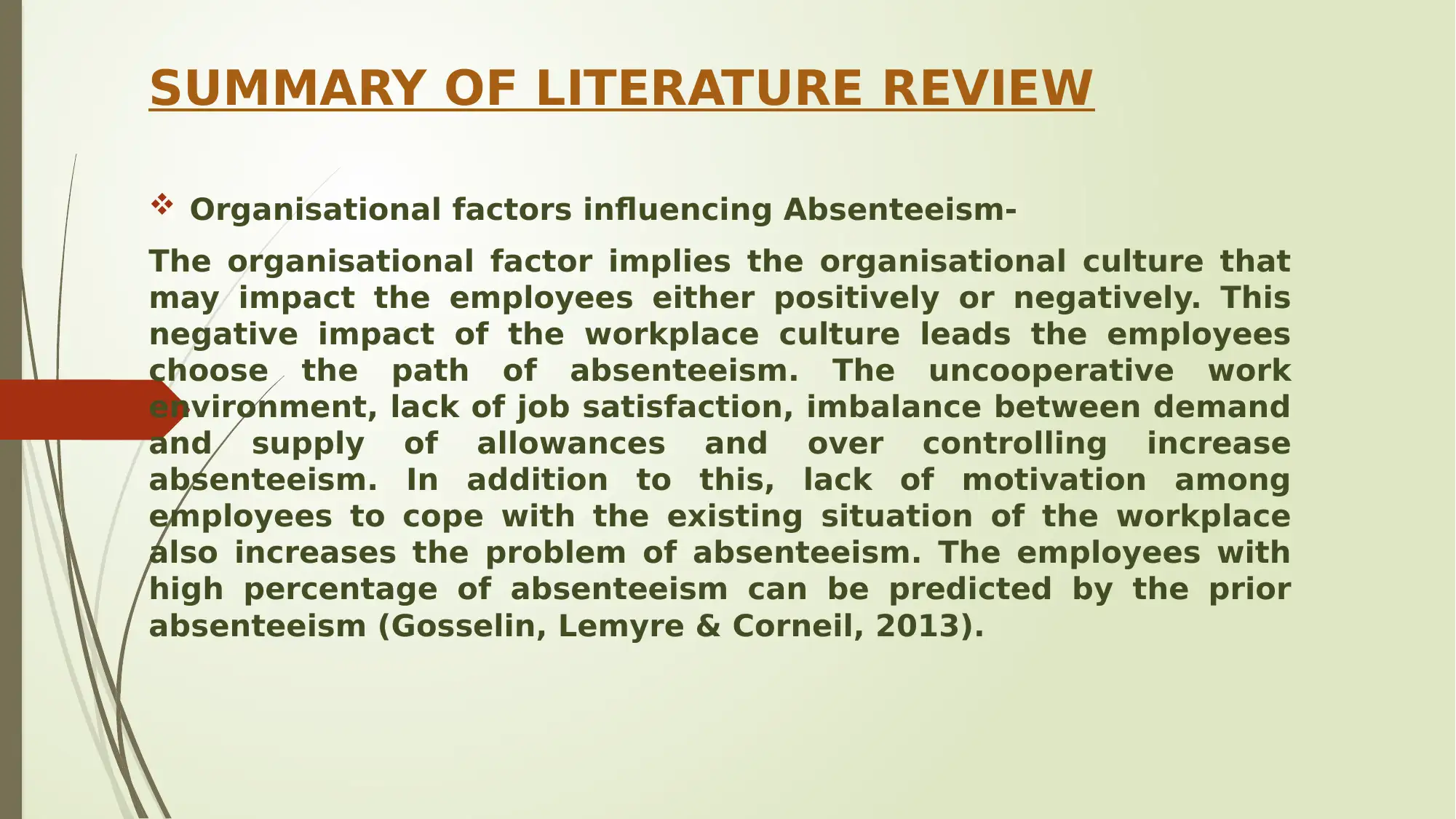
SUMMARY OF LITERATURE REVIEW
Organisational factors influencing Absenteeism-
The organisational factor implies the organisational culture that
may impact the employees either positively or negatively. This
negative impact of the workplace culture leads the employees
choose the path of absenteeism. The uncooperative work
environment, lack of job satisfaction, imbalance between demand
and supply of allowances and over controlling increase
absenteeism. In addition to this, lack of motivation among
employees to cope with the existing situation of the workplace
also increases the problem of absenteeism. The employees with
high percentage of absenteeism can be predicted by the prior
absenteeism (Gosselin, Lemyre & Corneil, 2013).
Organisational factors influencing Absenteeism-
The organisational factor implies the organisational culture that
may impact the employees either positively or negatively. This
negative impact of the workplace culture leads the employees
choose the path of absenteeism. The uncooperative work
environment, lack of job satisfaction, imbalance between demand
and supply of allowances and over controlling increase
absenteeism. In addition to this, lack of motivation among
employees to cope with the existing situation of the workplace
also increases the problem of absenteeism. The employees with
high percentage of absenteeism can be predicted by the prior
absenteeism (Gosselin, Lemyre & Corneil, 2013).
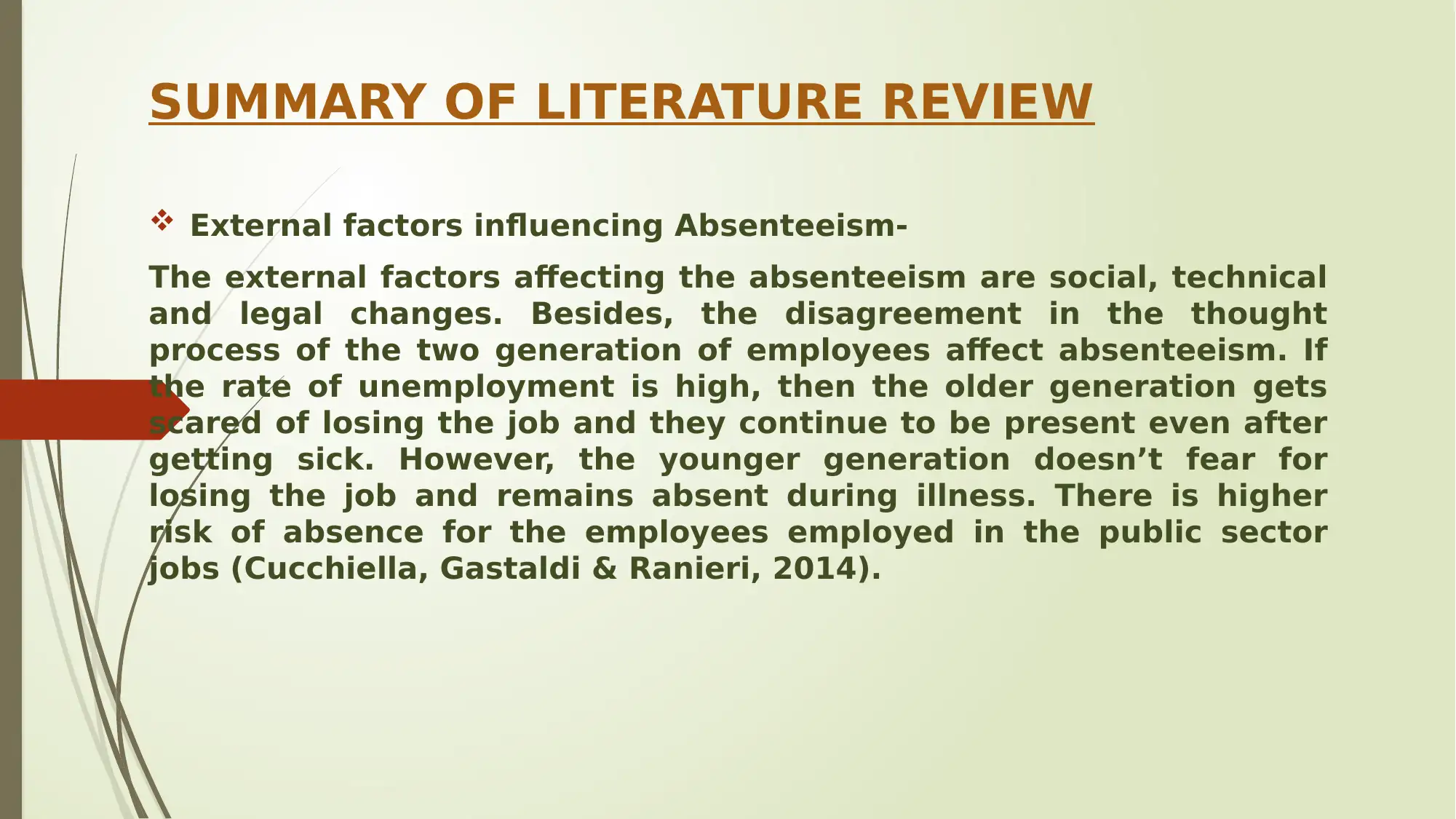
SUMMARY OF LITERATURE REVIEW
External factors influencing Absenteeism-
The external factors affecting the absenteeism are social, technical
and legal changes. Besides, the disagreement in the thought
process of the two generation of employees affect absenteeism. If
the rate of unemployment is high, then the older generation gets
scared of losing the job and they continue to be present even after
getting sick. However, the younger generation doesn’t fear for
losing the job and remains absent during illness. There is higher
risk of absence for the employees employed in the public sector
jobs (Cucchiella, Gastaldi & Ranieri, 2014).
External factors influencing Absenteeism-
The external factors affecting the absenteeism are social, technical
and legal changes. Besides, the disagreement in the thought
process of the two generation of employees affect absenteeism. If
the rate of unemployment is high, then the older generation gets
scared of losing the job and they continue to be present even after
getting sick. However, the younger generation doesn’t fear for
losing the job and remains absent during illness. There is higher
risk of absence for the employees employed in the public sector
jobs (Cucchiella, Gastaldi & Ranieri, 2014).
⊘ This is a preview!⊘
Do you want full access?
Subscribe today to unlock all pages.

Trusted by 1+ million students worldwide
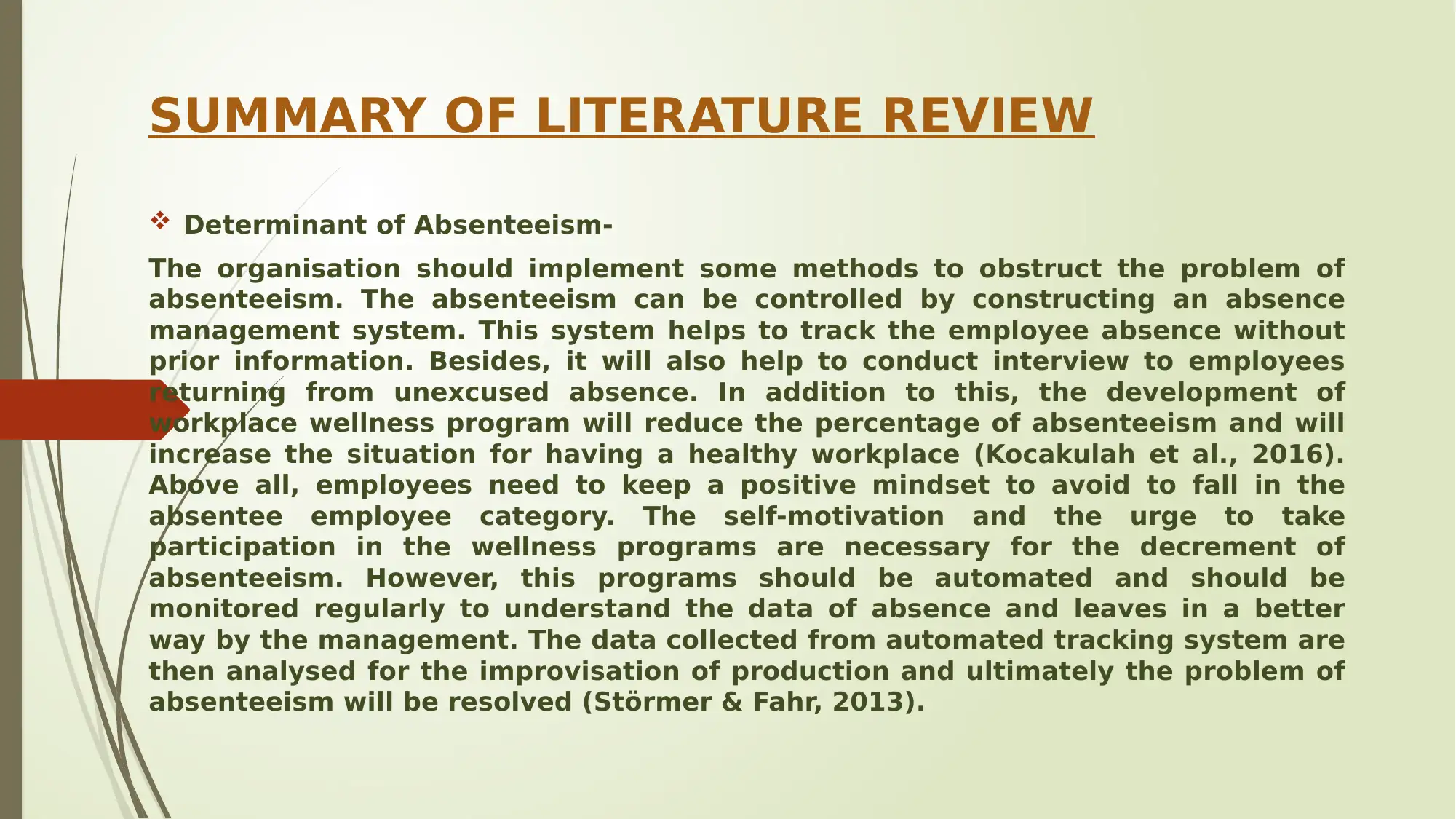
SUMMARY OF LITERATURE REVIEW
Determinant of Absenteeism-
The organisation should implement some methods to obstruct the problem of
absenteeism. The absenteeism can be controlled by constructing an absence
management system. This system helps to track the employee absence without
prior information. Besides, it will also help to conduct interview to employees
returning from unexcused absence. In addition to this, the development of
workplace wellness program will reduce the percentage of absenteeism and will
increase the situation for having a healthy workplace (Kocakulah et al., 2016).
Above all, employees need to keep a positive mindset to avoid to fall in the
absentee employee category. The self-motivation and the urge to take
participation in the wellness programs are necessary for the decrement of
absenteeism. However, this programs should be automated and should be
monitored regularly to understand the data of absence and leaves in a better
way by the management. The data collected from automated tracking system are
then analysed for the improvisation of production and ultimately the problem of
absenteeism will be resolved (Störmer & Fahr, 2013).
Determinant of Absenteeism-
The organisation should implement some methods to obstruct the problem of
absenteeism. The absenteeism can be controlled by constructing an absence
management system. This system helps to track the employee absence without
prior information. Besides, it will also help to conduct interview to employees
returning from unexcused absence. In addition to this, the development of
workplace wellness program will reduce the percentage of absenteeism and will
increase the situation for having a healthy workplace (Kocakulah et al., 2016).
Above all, employees need to keep a positive mindset to avoid to fall in the
absentee employee category. The self-motivation and the urge to take
participation in the wellness programs are necessary for the decrement of
absenteeism. However, this programs should be automated and should be
monitored regularly to understand the data of absence and leaves in a better
way by the management. The data collected from automated tracking system are
then analysed for the improvisation of production and ultimately the problem of
absenteeism will be resolved (Störmer & Fahr, 2013).
Paraphrase This Document
Need a fresh take? Get an instant paraphrase of this document with our AI Paraphraser
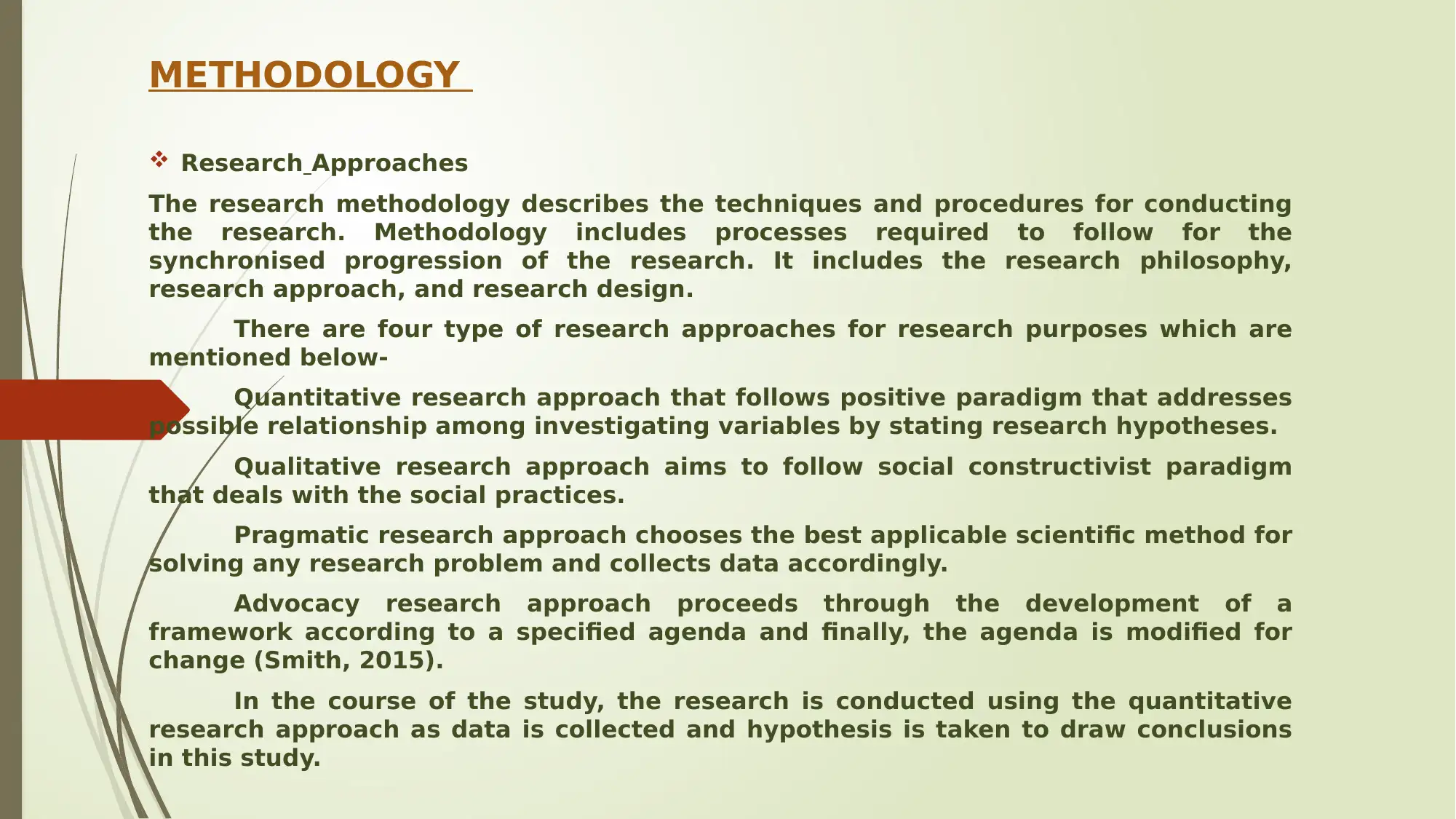
METHODOLOGY
Research Approaches
The research methodology describes the techniques and procedures for conducting
the research. Methodology includes processes required to follow for the
synchronised progression of the research. It includes the research philosophy,
research approach, and research design.
There are four type of research approaches for research purposes which are
mentioned below-
Quantitative research approach that follows positive paradigm that addresses
possible relationship among investigating variables by stating research hypotheses.
Qualitative research approach aims to follow social constructivist paradigm
that deals with the social practices.
Pragmatic research approach chooses the best applicable scientific method for
solving any research problem and collects data accordingly.
Advocacy research approach proceeds through the development of a
framework according to a specified agenda and finally, the agenda is modified for
change (Smith, 2015).
In the course of the study, the research is conducted using the quantitative
research approach as data is collected and hypothesis is taken to draw conclusions
in this study.
Research Approaches
The research methodology describes the techniques and procedures for conducting
the research. Methodology includes processes required to follow for the
synchronised progression of the research. It includes the research philosophy,
research approach, and research design.
There are four type of research approaches for research purposes which are
mentioned below-
Quantitative research approach that follows positive paradigm that addresses
possible relationship among investigating variables by stating research hypotheses.
Qualitative research approach aims to follow social constructivist paradigm
that deals with the social practices.
Pragmatic research approach chooses the best applicable scientific method for
solving any research problem and collects data accordingly.
Advocacy research approach proceeds through the development of a
framework according to a specified agenda and finally, the agenda is modified for
change (Smith, 2015).
In the course of the study, the research is conducted using the quantitative
research approach as data is collected and hypothesis is taken to draw conclusions
in this study.
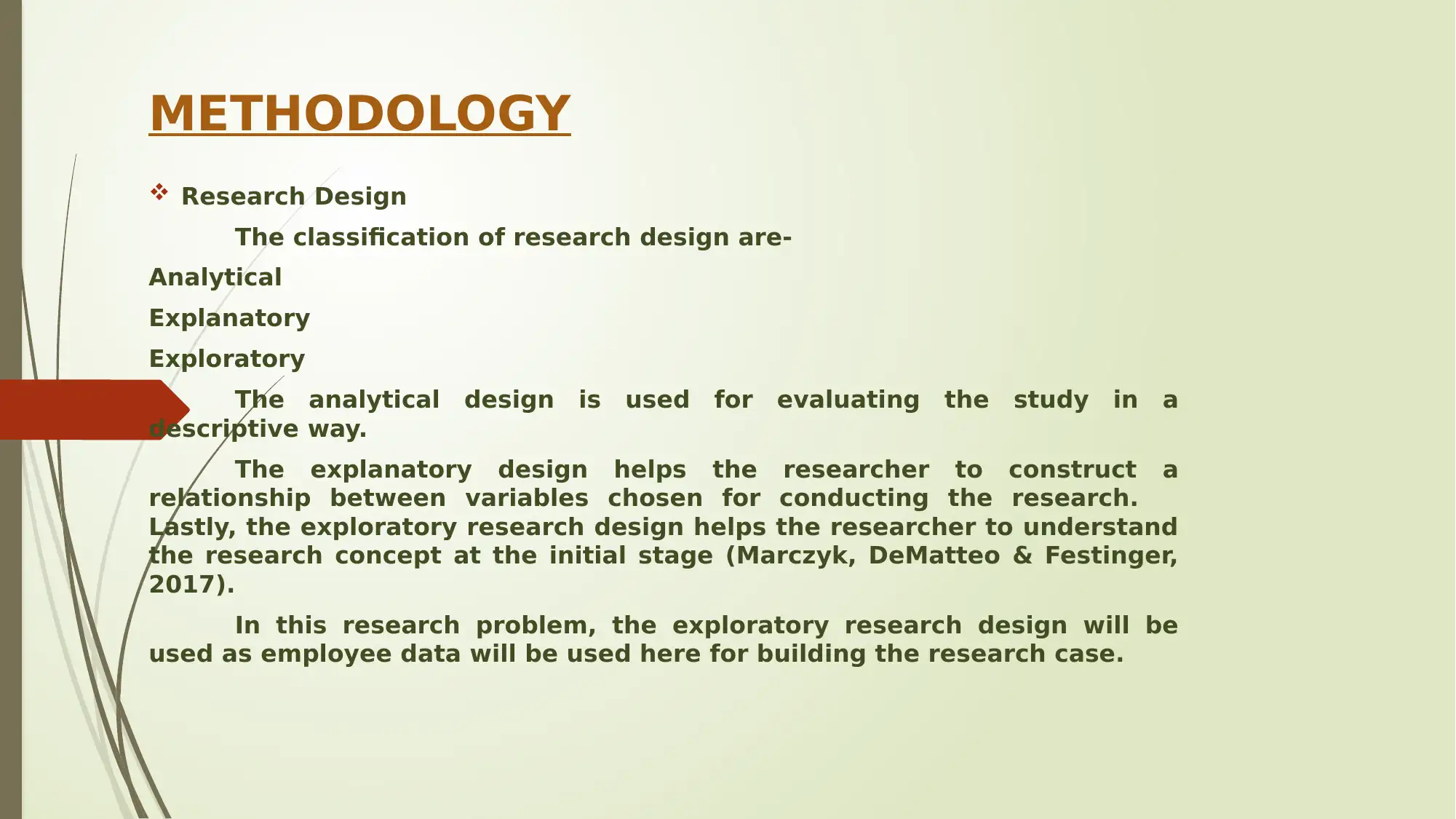
METHODOLOGY
Research Design
The classification of research design are-
Analytical
Explanatory
Exploratory
The analytical design is used for evaluating the study in a
descriptive way.
The explanatory design helps the researcher to construct a
relationship between variables chosen for conducting the research.
Lastly, the exploratory research design helps the researcher to understand
the research concept at the initial stage (Marczyk, DeMatteo & Festinger,
2017).
In this research problem, the exploratory research design will be
used as employee data will be used here for building the research case.
Research Design
The classification of research design are-
Analytical
Explanatory
Exploratory
The analytical design is used for evaluating the study in a
descriptive way.
The explanatory design helps the researcher to construct a
relationship between variables chosen for conducting the research.
Lastly, the exploratory research design helps the researcher to understand
the research concept at the initial stage (Marczyk, DeMatteo & Festinger,
2017).
In this research problem, the exploratory research design will be
used as employee data will be used here for building the research case.
⊘ This is a preview!⊘
Do you want full access?
Subscribe today to unlock all pages.

Trusted by 1+ million students worldwide
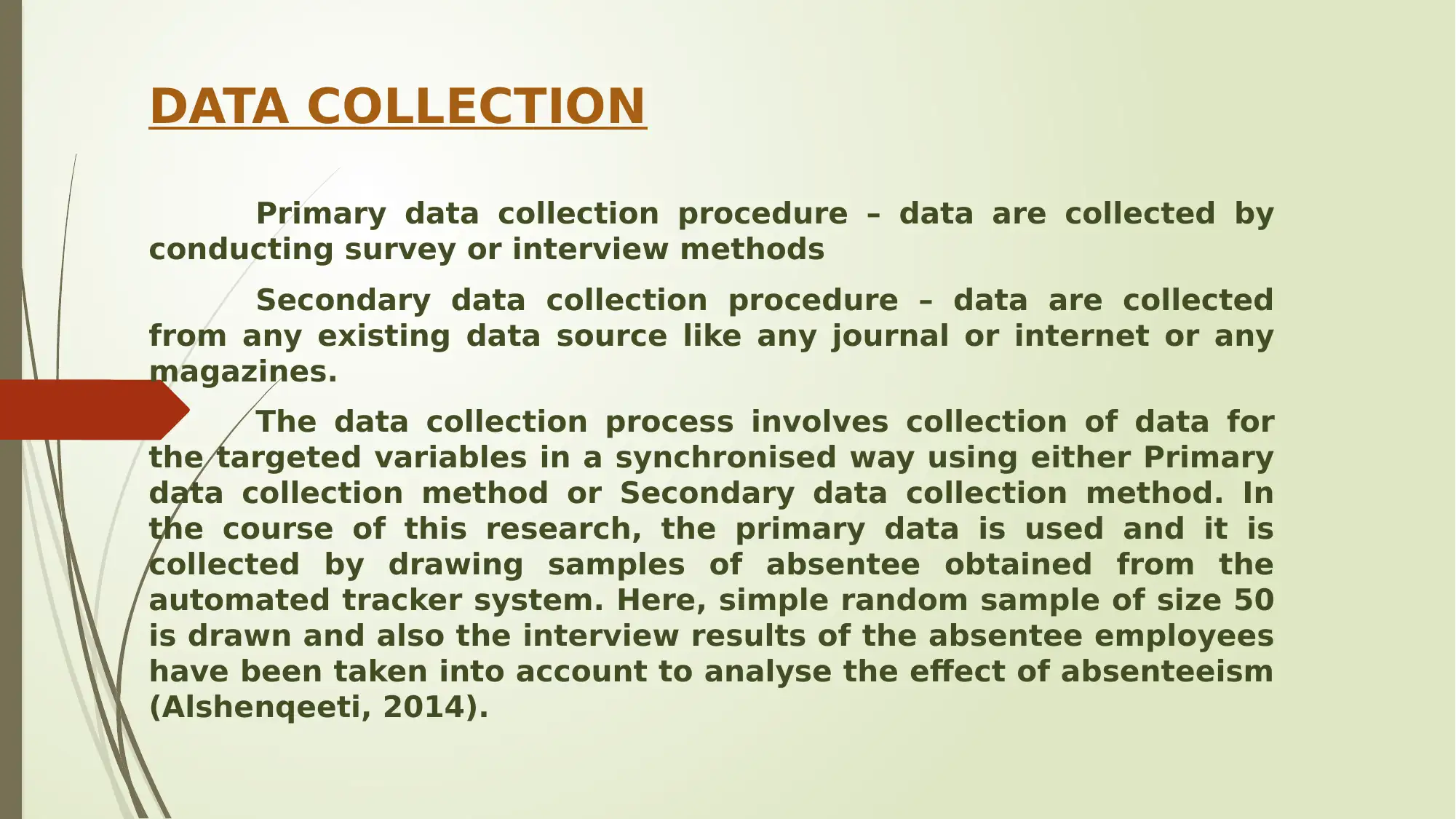
DATA COLLECTION
Primary data collection procedure – data are collected by
conducting survey or interview methods
Secondary data collection procedure – data are collected
from any existing data source like any journal or internet or any
magazines.
The data collection process involves collection of data for
the targeted variables in a synchronised way using either Primary
data collection method or Secondary data collection method. In
the course of this research, the primary data is used and it is
collected by drawing samples of absentee obtained from the
automated tracker system. Here, simple random sample of size 50
is drawn and also the interview results of the absentee employees
have been taken into account to analyse the effect of absenteeism
(Alshenqeeti, 2014).
Primary data collection procedure – data are collected by
conducting survey or interview methods
Secondary data collection procedure – data are collected
from any existing data source like any journal or internet or any
magazines.
The data collection process involves collection of data for
the targeted variables in a synchronised way using either Primary
data collection method or Secondary data collection method. In
the course of this research, the primary data is used and it is
collected by drawing samples of absentee obtained from the
automated tracker system. Here, simple random sample of size 50
is drawn and also the interview results of the absentee employees
have been taken into account to analyse the effect of absenteeism
(Alshenqeeti, 2014).
Paraphrase This Document
Need a fresh take? Get an instant paraphrase of this document with our AI Paraphraser
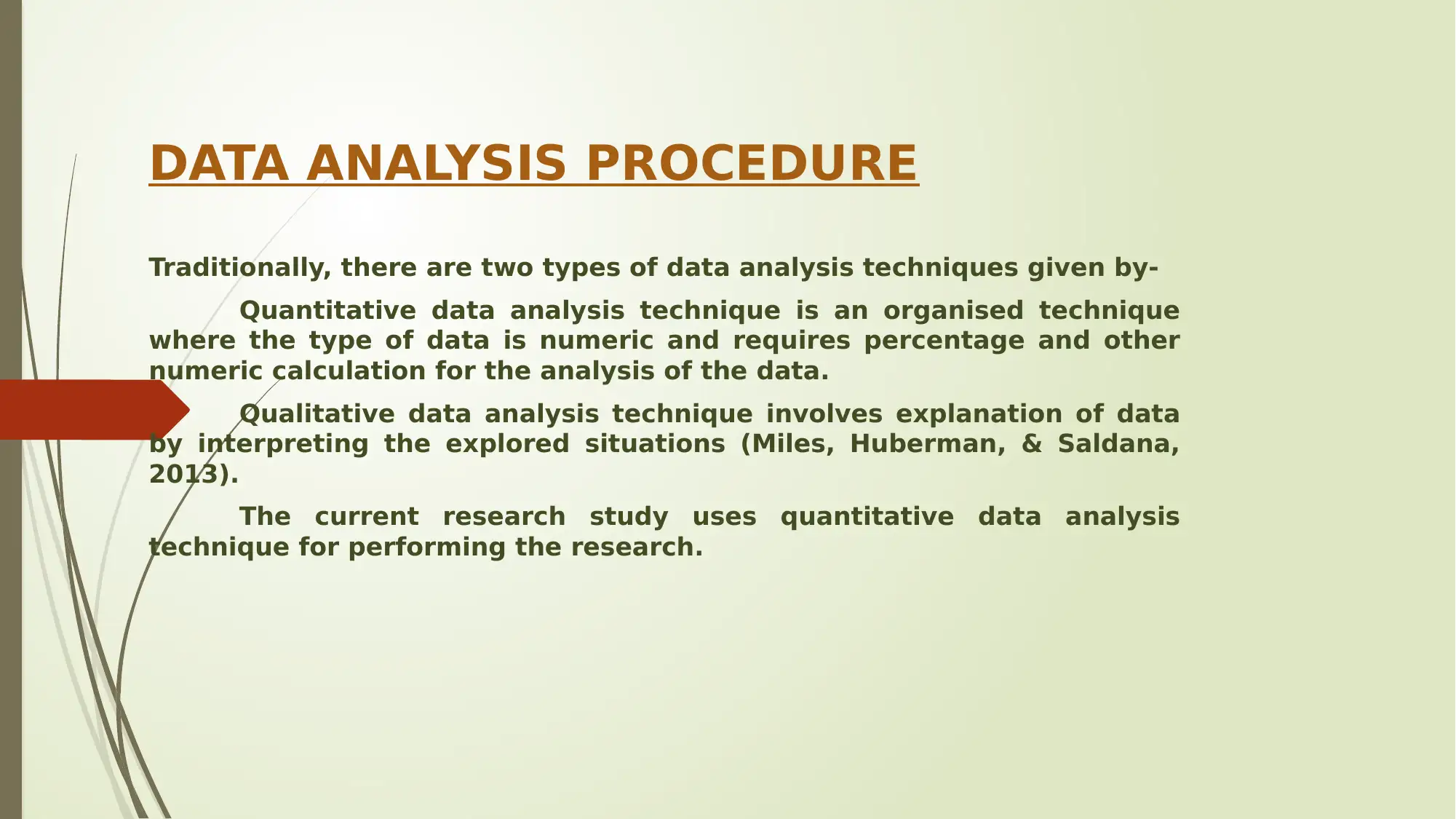
DATA ANALYSIS PROCEDURE
Traditionally, there are two types of data analysis techniques given by-
Quantitative data analysis technique is an organised technique
where the type of data is numeric and requires percentage and other
numeric calculation for the analysis of the data.
Qualitative data analysis technique involves explanation of data
by interpreting the explored situations (Miles, Huberman, & Saldana,
2013).
The current research study uses quantitative data analysis
technique for performing the research.
Traditionally, there are two types of data analysis techniques given by-
Quantitative data analysis technique is an organised technique
where the type of data is numeric and requires percentage and other
numeric calculation for the analysis of the data.
Qualitative data analysis technique involves explanation of data
by interpreting the explored situations (Miles, Huberman, & Saldana,
2013).
The current research study uses quantitative data analysis
technique for performing the research.
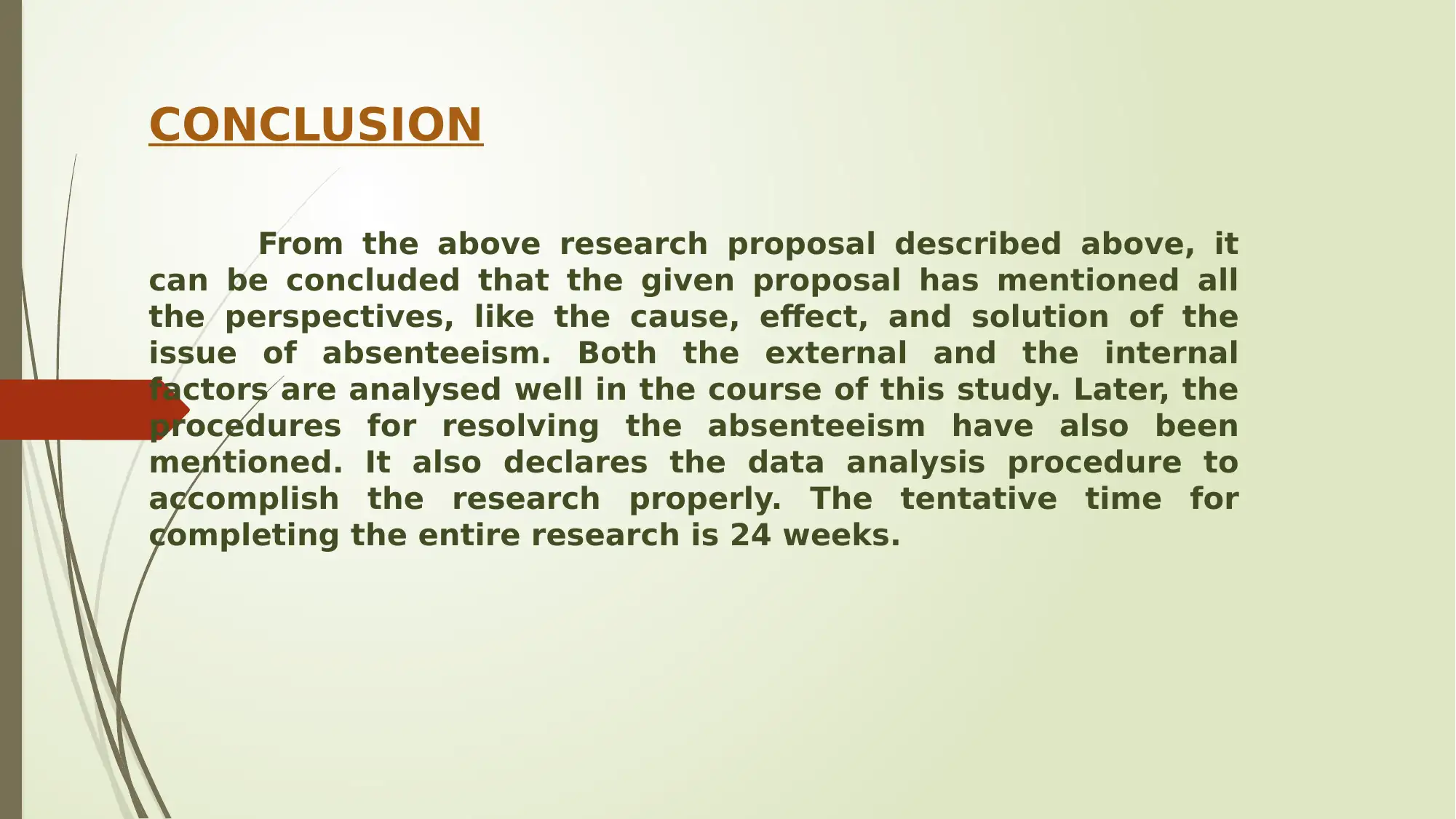
CONCLUSION
From the above research proposal described above, it
can be concluded that the given proposal has mentioned all
the perspectives, like the cause, effect, and solution of the
issue of absenteeism. Both the external and the internal
factors are analysed well in the course of this study. Later, the
procedures for resolving the absenteeism have also been
mentioned. It also declares the data analysis procedure to
accomplish the research properly. The tentative time for
completing the entire research is 24 weeks.
From the above research proposal described above, it
can be concluded that the given proposal has mentioned all
the perspectives, like the cause, effect, and solution of the
issue of absenteeism. Both the external and the internal
factors are analysed well in the course of this study. Later, the
procedures for resolving the absenteeism have also been
mentioned. It also declares the data analysis procedure to
accomplish the research properly. The tentative time for
completing the entire research is 24 weeks.
⊘ This is a preview!⊘
Do you want full access?
Subscribe today to unlock all pages.

Trusted by 1+ million students worldwide
1 out of 14
Related Documents
Your All-in-One AI-Powered Toolkit for Academic Success.
+13062052269
info@desklib.com
Available 24*7 on WhatsApp / Email
![[object Object]](/_next/static/media/star-bottom.7253800d.svg)
Unlock your academic potential
Copyright © 2020–2025 A2Z Services. All Rights Reserved. Developed and managed by ZUCOL.




